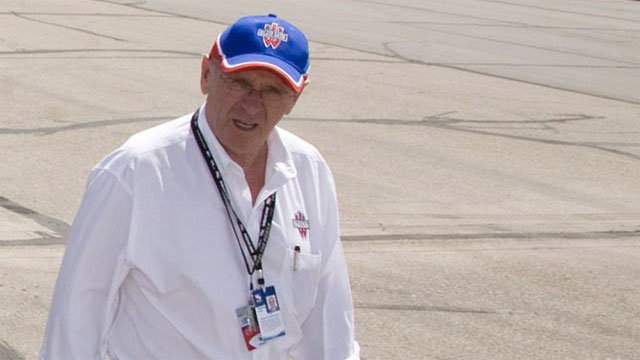TORONTO — IndyCar’s new president of competition said Sunday he was in agreement with acting race director Brian Barnhart to penalize Dario Franchitti in the first race at Toronto, then later overturn the call.
Derrick Walker also said he has final authority on all calls in race control during a candid interview Sunday with The Associated Press about specific officiating decisions in Saturday’s race. Walker believes IndyCar officiating needs to be more consistent, and the series needs to urgently invest in upgraded technology to improve race control.
The most glaring call Saturday, in the first of two races around the street course at Exhibition Place, stripped Franchitti of a third-place finish while he was participating in the post-race celebration. Penalized for blocking Will Power on the final lap, the call was overturned two hours later following an appeal from Franchitti’s race team.
“Brian ultimately consults with me on the calls,” Walker said in outlining the nine-person race control room in which Walker has final authority.
“In this instance, Brian and I were in agreement on both aspects — that it was a penalty, and then after reviewing it, in agreement that you need to be able to stand up and be big boys and say ‘Hey, you did get third place after all.’ If we were not in agreement, or Brian thought otherwise, ultimately I would say to Brian, ‘I think we should let him off.”‘
Walker, who took over his job at the end of May, said the decision to penalize Franchitti was based on the only camera angle they had access to in race control. It was a head-on shot that showed Franchitti appear to move to the left to block Power, then swing back to the right when Power adjusted to the other side.
With nothing else at their disposal to review the call, race control hurriedly issued a 25-second penalty that knocked Franchitti out of third. He was informed by a team member after he’d already accepted the trophy and was about to participate in the celebratory champagne spray.
“We’re seeing the podium evolve and we’re giving (Franchitti) a penalty and we don’t know how to stop (the podium),” Walker said.
Once IndyCar officials returned to their at-track operations truck, they were met by several Target Chip Ganassi Racing team members with data to prove Franchitti didn’t block Power. Franchitti arrived an hour after the race to make what Walker called “a passionate presentation.”
Ultimately, officials were finally able to get two camera angles — one from Power’s onboard camera and an aerial shot — that proved Franchitti was innocent.
“IndyCar needs to invest some money in new technology,” Walker said. “The competition has gotten better and IndyCar needs to invest some money in equipment, so we can be the kind of organization (the fans) want us to be. That’s not just being the village policeman, but being able to look at all of those views.
“There’s a lot of cameras around this place, not all of them get beamed into our race control. We’re limited and some of our screens are too small and not all of them are in high def. And HD makes a big difference. We actually need to completely revise what we’ve got and upgrade it.”
Walker said the lack of cameras were behind the decision to stop warning teams mid-race about driving with more than two wheels over the curbs.
He explained that tire barriers had been removed from certain corners to prevent drivers from running into them and bringing out lengthy yellow flags. The result was drivers were driving straight across the curb, “which is very dangerous,” Walker said.
IndyCar started the race issuing warnings but quickly gave up.
“We get into the race and the camera view wasn’t always facing there so we could see the cars,” Walker said. “Almost immediately, we realized we couldn’t even police it. So we sent a note saying, ‘Guys, knock yourself out on the curbs.’ But last night we decided we had to stop them from doing that. We tried the honour system and that didn’t work, so we put the tire (barriers) back out.
“Now it’s on them to stay off of them because if they run into the tires, they are going to bring out yellow.”
The issues came about on a weekend in which Barnhart returned to race control for the first time since the 2011 season finale. He was summoned for the role on no notice Thursday, Walker said, when current IndyCar race director Beaux Barfield couldn’t enter Canada because of an immigration issue.
Although the paddock supports Barnhart, he’s much maligned among fans who are critical of his officiating. Franchitti implored fans on Twitter on Saturday night to lay off Barnhart, arguing it was not an individual decision by Barnhart to issue the penalty.
Walker also said Barnhart was fine.
“I think he was a little apprehensive to start with, not knowing how he’d be received,” Walker said. “He’s giving it his best. Nobody has all the answers and he’s got a lot more support now then he had back then. He was a lone wolf back then and he did his best then, but now he’s got a lot more support. There’s a different atmosphere about the place, it’s about working together and team spirit.”
Walker acknowledged that Barnhart and Barfield, who will return to race control at the next race, have different officiating styles and that Walker “is still trying to understand” Barfield’s style after Barnhart held the job from 1997 until 2011.
“Beaux has a lot of experience, he has a different style in dealing with it,” Walker said. “He does a lot of one-on-one in dealing with people, a lot of personal contact. So it’s just different styles and doing things in different ways. I’m not saying which one is better because I am the new guy on the block.”
But Walker said the series is not consistent enough for his liking.
“We need to be better, and better needs better tools and better procedures,” Walker said. “It’s not as simple as it looks. There’s a lot of work that goes into it and this is a lean, mean machine. We don’t have a ton of people doing these jobs. We have good employees. We just need more of them and a direction on where we are going.”
Among the other things Walker said is IndyCar decided to use a standing start in Sunday’s race because “we could hear the boos” from the crowd in race control when Saturday’s standing start was aborted. The series was only scheduled to try standing starts on Saturday.
“The fans told us they wanted it, so let’s do it again,” Walker said.










